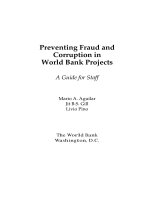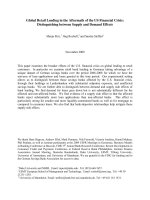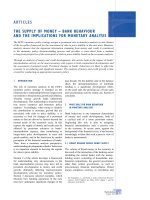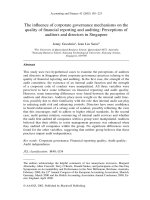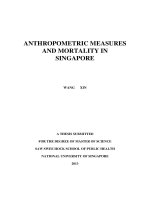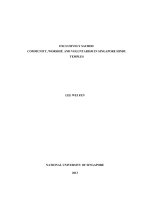sandhu - financial fraud; money scams, embezzlement and swindles in singapore (2013)
Bạn đang xem bản rút gọn của tài liệu. Xem và tải ngay bản đầy đủ của tài liệu tại đây (544.38 KB, 177 trang )
FINANCIAL FRAUD
FRAUD
FINANCIAL
BALVINDER SANDHU
© 2013 Marshall Cavendish International (Asia) Private Limited
Published by Marshall Cavendish Editions
An imprint of Marshall Cavendish International
1 New Industrial Road, Singapore 536196
All rights reserved
No part of this publication may be reproduced, stored in a retrieval system or transmitted,
in any form or by any means, electronic, mechanical, photocopying, recording or otherwise,
without the prior permission of the copyright owner. Request for permission should be
addressed to the Publisher, Marshall Cavendish International (Asia) Private Limited,
1 New Industrial Road, Singapore 536196. Tel: (65) 6213 9300, Fax: (65) 6285 4871.
E-mail: Website: www.marshallcavendish.com/genref
The publisher makes no representation or warranties with respect to the contents of this
book, and specifically disclaims any implied warranties or merchantability or fitness for any
particular purpose, and shall in no event be liable for any loss of profit or any other commercial
damage, including but not limited to special, incidental, consequential, or other damages.
Other Marshall Cavendish Offices:
Marshall Cavendish Corporation. 99 White Plains Road, Tarrytown NY 10591-9001, USA
• Marshall Cavendish International (Thailand) Co Ltd. 253 Asoke, 12th Flr, Sukhumvit
21 Road, Klongtoey Nua, Wattana, Bangkok 10110, Thailand • Marshall Cavendish
(Malaysia) Sdn Bhd, Times Subang, Lot 46, Subang Hi-Tech Industrial Park, Batu Tiga,
40000 Shah Alam, Selangor Darul Ehsan, Malaysia
Marshall Cavendish is a trademark of Times Publishing Limited
National Library Board, Singapore Cataloguing-in-Publication Data
Sandhu, Balvinder.
Financial fraud / Balvinder Sandhu. – Singapore : Marshall Cavendish Editions, [2013]
pages cm
ISBN : 978-981-4398-39-8 (paperback)
1. White collar crimes – Singapore. 2. Fraud – Singapore. 3. Commercial crimes – Singapore.
4. Commercial criminals – Singapore. I. Title.
HV6771.S55
364.168095957 — dc23 OCN840879271
Printed in Singapore by Fabulous Printers Pte Lrd
Cover design by Benson Tan
Cover photo courtesy of Svilen Milev, www.efffective.com
Contents
Introduction 7
Chapter 1 The Man Who Brought Down A Bank 11
Chapter 2 The Taxman's Revenge 45
Chapter 3 Charity Under Fire 57
Chapter 4 Cheats Get Caught 71
Chapter 5 Brewery Scandal 83
Chapter 6 Stealing On The Job 107
Chapter 7 Civil Servants Gone Wild 115
Chapter 8 Dead Man Walking 133
Chapter 9 Lawyer On The Loose 151
About the Author 174
Introduction
Introduction
WHITE-COLLAR CRIME IS not without its casualties.
While it usually does not involve death or physical harm,
individuals or companies are nonetheless victimised, be
it in terms of the loss of money or value of a product, or
even that of the company itself.
T
he list of financially-
motivated crimes include cheating, forgery, embezzlement
and fraud.
Some of the criminals mentioned in this book ar
e
famous—or should we say infamous—while others were
involved in relatively low-key crimes. But this does not
detract from the fact that they have committed crimes
and have been made to pay for them.
One of
S
ingapor
e’s most famous cases was that of
trader Nick
L
eeson, who was responsible for bringing
down one of
E
ngland
’s oldest financial institutions.
T
hen there was the case of David Rasif, the lawyer who
absconded after taking millions of his clients’ money,
and who is still on the run today.
A
nd who can forget the case involving the National
Kidney Foundation (NKF), in which its CEO was
accused of misappropriating the charity’s funds?
Even senior finance managers often succumb to greed,
betraying their employer’s trust to fund their lavish
lifestyles or gambling habits, or on expensive gifts for
their mistresses. Such cases include that of Chia Teck
Leng from Asia-Pacific Breweries (APB), who pocketed
over $100 million of the company’s money, as well
as civil servants Koh Seah Wee and Lim Chai Meng,
who worked at Singapore Land Authority (SLA) and
effectively cheated the government organisation of more
than $10 million.
Financial Fraud also profiles other small-scale criminals
who might not have benefited near as much financially,
but committed severe crimes nonetheless.
But as we find out, be they small-time crooks or
seasoned swindlers, no one is above the law.
9Introduction
The Man Who Brought Down A Bank
Chapter 1:
The Man Who
Brought Down
A Bank
IF THERE EVER was a financial crime in Singapore
that garnered the most international interest, it was the
case of Nick Leeson. The Englishman was responsible for
bringing down Barings, one of Britain’s oldest and most
prestigious merchant banks. As if that wasn’t shocking
enough, he was also just a few days shy of turning 28
when it happened.
Just how did a young and relatively inexperienced
trader cause the downfall of a 223-year-old blue-chip
bank, of which even Queen Elizabeth was a customer?
The collapse happened in late February 1995 and was
sparked off by Leeson initiating US$27 billion worth of
reckless trades on Japanese futures contracts.
Leeson was general manager of Barings Futures
(Singapore) (BFS) and was seen as a whiz-kid trader
because of the amount of money he was thought to be
making the bank. Of course, a lot of this wasn’t actually
true—Leeson was allegedly falsifying accounts and
recording fictitious trades in order to hide his trading
losses in Japanese stock futures. When this finally came
to the bank’s notice, it had already lost £860 million.
ACCOUNT 88888
Leeson joined Baring Securities London (BSL) in 1989
and was posted to Singapore in April 1992. In July,
he opened Account 88888, a secret error account in
Baring’s internal accounting system meant to record
‘small’ error trades. By December 1992, the account had
accumulated losses of £2 million stemming from Leeson’s
trading activities. In December 1993, Account 88888
hid cumulative losses of £23 million. Just a year later,
the figure had ballooned to a whopping £208 million.
On 17 January 1995, the Kobe earthquake shook Japan
and its stock market suffered as a result. Leeson decided
to try and recoup his losses by gambling heavily on a
strong recovery in the Nikkei 225 futures share prices. He
continued gambling as the market slid further, eventually
accumulating a loss of £827 million.
While on secondment to the group’s Singapore
office, a senior settlements clerk from Barings London
uncovered a US$190 million ‘hole’ in Leeson’s account
on 23 February. But before he could get an answer from
Leeson, the former general manager left the office, never
to return again.
Chapter 1: The Man Who Brought Down A Bank 13
THE BLAME GAME BEGINS
On 26 February 1995, the Bank of England announced
that Barings had been put under administration.
In Singapore, the Commercial Affairs Department
(CAD)—which probes white-collar offences—started
its investigations by questioning key senior Barings
employees such as regional managing director James
Bax and director Simon Jones. Both surrendered their
passports to the CAD. Bax was in charge of the group’s
Asian operations outside of Japan and reportedly told
the CAD that he had no control over Leeson’s trading
activities as the trader answered directly to London.
Although there were rumours that Barings PLC had
sent a team to Singapore to check the books just a week
before the crisis erupted, the bank denied these allegations
and claimed to have no idea of the losses suffered by its
Singapore offices.
British newspapers reported that investigators had
evidence that Barings’ treasury department in London had
advanced as much as US$70 million to Leeson. Another
report said that Leeson had obtained an extra US$130
million in February alone. However, a Barings spokesman
dismissed these reports as being “purely fictitious”.
A source told The Straits Times in early March that
Barings had conducted investigations even before Leeson
fled town on 23 February.
14 Financial Fraud
“Obviously, Barings knew beforehand something
had gone wrong and flew three officials down to go
through the books before the whole case blew up,” said
the source. “The officials left in haste just before the
authorities moved in and placed Baring Futures under
judicial management.”
Both the Singapore and British authorities conducted
investigations on alleged fraud and falsification of
accounts. Judicial managers from Price Waterhouse
went through the books and said that they were getting
assistance from Leeson, who was arrested in Frankfurt,
Germany, on 2 March.
When Leeson went missing and the world was talking
about him and how he brought down a British institution,
it turns out that he and his wife Lisa were catching some
sun by a hotel pool in Kota Kinabalu. The couple had
checked in to the Tanjong Aru Beach Resort in the East
Malaysian state of Sabah and checked out on 28 February.
They departed for Bandar Seri Begawan (Brunei’s
capital city) the next day, and spent the day at the airport’s
transit lounge before flying on two economy class tickets
to Frankfurt, Germany that evening.
As more details emerged about the case, it seemed that
both the bank and the Singapore authorities were aware
that something wasn’t quite right with the operations
that Leeson was handling. An internal audit that Barings
Chapter 1: The Man Who Brought Down A Bank 15
PLC had done in August 1994 highlighted the problems
that eventually led to the bank’s downfall. Although
top Barings executives in London were aware that the
Singapore futures arm was exposed to “significant risks”
because Leeson had too much control over both dealing
and settlement operations, they chose to keep him as
general manager because of his experience and the profits
he had generated for the bank. BFS had raked in profits
of $20 million in 1994.
And despite the report’s recommendations that Leeson
should not retain responsibility for supervision, cheque-
signing and other back-office functions, these suggestions
were ignored.
NO CONTROLS OVER LEESON
In January 1995, the Singapore International Monetary
Exchange (SIMEX)—now known as the Singapore
Exchange (SGX)—had also warned Barings about the
huge volume of trade built up by its Singapore futures
arm. The top management of Barings PLC assured SIMEX
that the bank had enough assets to back its trades.
This assurance was given by Barings group treasurer
Anthony Hawes, who had flown to Singapore in January
after a series of exchanges between SIMEX and the bank
of London. Because margin calls were met, SIMEX saw
16 Financial Fraud
no need at the time to suspend BFS from trading. But the
chairman of SIMEX, Elizabeth Sam, noted that BFS only
had four clients—three were part of the Barings group
and the other was Banque Nationale de Paris.
“The failure of internal controls within the Barings
group has allowed the general manager of BFS to commit
the Barings group to substantial positions which now
account for the loss sustained by the Barings group,”
she said.
The findings also revealed that Leeson had directed
his staff to modify the relevant records, and that “Leeson
was able to do this as he was the key manager appointed
by Barings UK to take charge of the dealing and trade
settlement functions.”
As such, he was “placed in a position where he
could both initiate transactions and also ensure that
transactions were settled and recorded in accordance with
his own instructions”.
This lack of control over Leeson’s dealings seems to
have contributed significantly to the bank’s downfall.
The issue actually been brought up before—in a letter
dated 25 March 1992, Bax had alerted London of the
danger placed on its Singapore arm, even before Leeson
was made general manager of BFS.
This letter was directed to Andrew Fraser, head of
equities, and it said: “My concern is that once again we are
Chapter 1: The Man Who Brought Down A Bank 17
in danger of setting up a structure which will subsequently
prove disastrous and with which we will succeed in losing
either a lot of money, or client goodwill, or both.”
“In my view, it is critical we should keep clear
reporting lines, and if this office is involved in SIMEX,
then Nick (Leeson) should report to Simon (Jones, a
Barings director) and then be ultimately responsible for
the operations side.”
“If this is not the case, then the involvement of
both Simon and myself (as current director of BFS) is
inappropriate and needs review.”
As investigations into Barings continued, a host of
discrepancies and non-professional behaviour soon came
to light. It was first revealed that documents detailing the
million-dollar deals in the last eight weeks of Leeson’s trades
were missing from BFS and believed to have been shredded.
Thankfully, SIMEX had a complete set of records of
Leeson’s transactions. Addressing rumours that Barings
records were shredded on a daily basis, Charles Sng, the
SIMEX spokesman, noted that firms were “required under
the Futures Trading Act to keep records for at least six years”.
A few days later, it was revealed that Barings had
suppressed information that Leeson was caught lying to
18 Financial Fraud
British regulators when applying for a London trading
licence in March 1992. Had regulators in Singapore been
informed, they would have demanded more information
before deciding whether he would be allowed to work
here as a futures trader.
Christopher Sharples, chairman of London’s Securities
and Futures Authority (SFA), was quoted by BBC as
saying that Leeson had lied on his application form and
that Barings had been informed.
In the form, Leeson was asked whether he had been
the subject of any criminal proceedings or had any county
court judgements against him. He answered no, even
though he had two outstanding judgements amounting
to about £3,000. When Barings was informed, they
withdrew Leeson’s name as they knew that he would not
have been granted a licence in Britain.
As he didn’t require a trading licence from SIMEX at
the time, he started working in BFS.
DID HE ACT ALONE?
Contradictory reports from different sources soon
emerged as to whether Leeson acted alone or if he had
help from people in London.
In Singapore, the CAD conducted a probe into
Leeson’s possible fraud and to show that he forged two
Chapter 1: The Man Who Brought Down A Bank 19
documents to cover losses of 7.8 billion yen that he
sustained in derivatives trading. If they could prove this,
they had a case for extraditing him from Germany to face
fraud charges in Singapore, where the maximum sentence
for forgery was seven years in prison. (Following his arrest,
Leeson had told a German court that he didn’t want to be
extradited to Singapore.) London’s Serious Fraud Office
(SFO) backed the CAD and its request for extradition.
Another separate investigation was also taking place
locally, led by two inspectors from Price WaterHouse
who probed allegations of fraud and misconduct by
those linked to the Barings scandal. These inspectors
were appointed by then Finance Minister Richard Hu in
early March, and had wide-ranging authority to question
officials as well as to seize documents both in Singapore
and overseas.
In April, the Bank of England (BOE) admitted for the first
time that they did not know about all the cash transfers
taking place within Barings, which amounted to more
than double the bank’s total shareholders’ capital when
it eventually collapsed. BOE governor Eddie George said
that Barings PLC had broken the law by transferring large
sums of money to its Singapore operations without first
20 Financial Fraud
informing the British central bank. Banks are required
to inform the BOE in advance if they are transferring
money totalling more than 25 per cent of their capital.
“It is a criminal offence to advance the money without
notifying us,” said George. “I can be absolutely certain
to tell you that we did not know as of February 27 that
£443 million plus £317 million were advanced to the bank,”
he told the parliamentary committee cross-examining him
during the investigation.
In its last audited annual report, Barings’ total
shareholders’ funds stood at £308.8 million.
THE OFFICIAL INVESTIGATION REPORT
The Price WaterHouse inspectors appointed by the
Finance Minister released their report to him in September
and the findings were made public a month later. It
singled out Peter Norris, Barings’ chief executive at the
time, as the individual to blame for the bank’s collapse.
The 183-page report noted that the crisis could have
been averted if Norris and other executives, including
Bax, did not hinder investigations into a $115 million
discrepancy in BFS’ accounts. The report concluded
that the bank’s collapse was caused by “institutional
incompetence and a total failure of internal controls”.
Norris was named as “the man at the centre of an
Chapter 1: The Man Who Brought Down A Bank 21
effort” to downplay the significance of an unauthorised
transaction by Leeson that led to a hole worth $115 million
in the bank’s accounts. Although Norris was told about
this discrepancy, he discouraged all independent probes,
made sure that other directors were kept in the dark and
withheld any action against Leeson. He had also told Bax
to help to downplay the issue.
Bax purportedly then told Leeson to deceive the
auditors. When group treasurer Anthony Hawes came
to Singapore in February to investigate this discrepancy,
Bax instructed BFS financial director Simon Jones to “get
Nick (Leeson) out of this loop” and “take on” Hawes.
Even though both Bax and Jones had earlier denied
being involved in any cover-up, the inspectors wrote
that “we are unable to accept their denials”, noting that
key individuals were “grossly negligent, or wilfully blind
and reckless to the truth” because they kept on sending
money to BFS even though there were signs that all was
not well in the Singapore operations.
The report added that “had Mr Norris and Mr Bax not
taken such steps and as a result of proper investigations,
the flow of funds to BFS been curtailed, this may have
averted the collapse of the Barings group… Instead, in
the three weeks leading to February 24, Barings group
companies remitted about $1 billion to BFS.”
Another point it noted was that regardless of whether the
22 Financial Fraud
management knew about Account 88888 and what Leeson
was up to, they could still have taken steps to investigate.
“For three years, Account 88888 purportedly escaped
the notice of the entire Barings group management. Yet
within hours after Leeson had fled, Baring Securities
London personnel working in London and Singapore with
incomplete documentation uncovered Account 88888
and identified it as the immediate cause of the collapse.”
The report received international press coverage, the
majority of it favourable.
EXTRADITION FROM GERMANY
Following his arrest in Frankfurt on 2 March, Leeson
was detained, pending an application for extradition to
Singapore. As is the practice in extradition cases, German
prosecutors argued Singapore’s case against Leeson, with
CAD officers helping in the legal arguments.
In late March, German prosecutors asked for a report
on Singapore’s legal system and prison conditions in case
Leeson’s lawyers asked for him not to be extradited on
the grounds of human rights.
“Mr Leeson’s lawyer has announced that he will
make objections that prison conditions do not fulfil
international standards, and that Mr Leeson fears unfair
trial against him in Singapore,” said senior Frankfurt
Chapter 1: The Man Who Brought Down A Bank 23
prosecutor Hans-Hermann Eckert. Leeson’s lawyer,
Eberhard Kempf, did not bring up these objections in
court but had raised them privately with Eckert.
“The report will be precautionary, in case Mr Leeson’s
lawyers raise such objection,” Eckert told The Straits
Times. Since Leeson’s case came to light, British tabloids
had been generating reports about the adverse conditions
of prisons in Singapore. Terms such as “harsh justice”
and “worsening human rights record” were used liberally.
But Eckert wasn’t bothered by this coverage: “I think
that prison conditions in Singapore are agreeable and
normal, and that Mr Leeson can live in your prisons.”
There were also rumours that the UK Serious Fraud
Office (SFO) would seek to extradite Leeson to the UK
instead, to face charges there. However, in May 1995,
the SFO said that it wouldn’t be contesting any moves by
the Singapore authorities to extradite him. It had been
unable to find sufficient evidence of the involvement of
any London-based Barings employee in the alleged fraud,
which was the only grounds for extradition to England.
The following month, the Hesse State Superior Court
in Germany accepted all charges levied against Leeson in
Singapore’s extradition request. The court had initially
only accepted evidence supporting a single forgery charge
while it waited for the other charges to be translated to
German. But on 7 June, it ruled that the remaining 11
24 Financial Fraud

